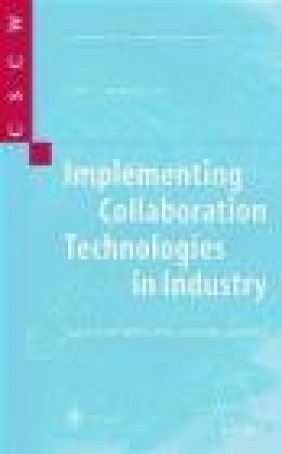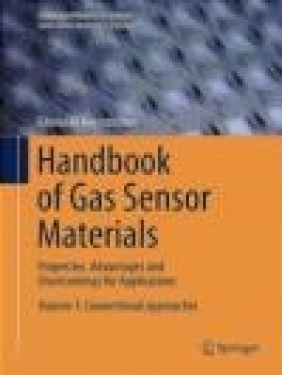Handbook of Gas Sensor Materials: Conventional Approaches Volume 1
Ghenadii Korotcenkov
Handbook of Gas Sensor Materials: Conventional Approaches Volume 1
Ghenadii Korotcenkov
- Wydawnictwo: Springer
- Rok wydania: 2013
- ISBN: 9781461471646
- Ilość stron: 442
- Oprawa: Twarda
Niedostępna
Opis: Handbook of Gas Sensor Materials: Conventional Approaches Volume 1 - Ghenadii Korotcenkov
The two volumes of Handbook of Gas Sensor Materials provide a detailed and comprehensive account of materials for gas sensors, including the properties and relative advantages of various materials. Since these sensors can be applied for the automation of myriad industrial processes, as well as for everyday monitoring of such activities as public safety, engine performance, medical therapeutics, and in many other situations, this handbook is of great value. Gas sensor designers will find a treasure trove of material in these two books.Vol. 1. Conventional Approaches Preface Chapter 1: Introduction 1. Gas sensors and their role in industry, agriculture, medicine and environment control 2. Gas sensors classification 3. Requirements to gas sensors 4. Comparative analysis of gas sensors 5. Materials acceptable for gas sensor applications References Part 1. Conventional Gas Sensing Materials Chapter 2: Metal oxides 1. General view 2. Which metal oxides are better for solid state electrochemical gas sensors? 3. Metal oxides with ionic conductivity: Solid electrolytes 3.1. Criterions for metal oxides application in solid electrolyte-based gas sensors 3.2. High temperature oxygen sensors 3.3. Solid electrolyte-based hydrogen sensors 3.4. Other gases 3.5. Limitations of solid electrolytes application in gas sensors 4. Semiconducting metal oxides 4.1. Metal oxides for chemiresistors 4.1.1. Binary metal oxides 4.1.2. Complex and mixed metal oxides 4.1.3. Metal oxide comparison and selection 4.2. Metal oxide p-n homojunction and heterostructures 4.3. High temperature oxygen sensors based on semiconducting metal oxides 5. Metal oxides for room temperature gas sensors 6. Other applications of metal oxides 6.1. Pyroelectric-based gas sensors 6.2. Thermoelectric-based sensors 6.3. Chemochromic materials for hydrogen sensors References Chapter 3: Polymers 1. General view 2. Polymer-based gas sensors 3. Mechanisms of conductivity change in polymer-based gas sensors 4. Ion conducting polymers and their using in electrochemical sensors 3. Limitations of polymer using in gas sensors 4. Choosing a polymer for gas sensor applications References Chapter 4: Thin metal films 1. Thin metal films in gas sensors 2. Disadvantages of sensors and approaches to sensor'Vol. 1. Conventional Approaches Preface Chapter 1: Introduction 1. Gas sensors and their role in industry, agriculture, medicine and environment control 2. Gas sensors classification 3. Requirements to gas sensors 4. Comparative analysis of gas sensors 5. Materials acceptable for gas sensor applications References Part 1. Conventional Gas Sensing Materials Chapter 2: Metal oxides 1. General view 2. Which metal oxides are better for solid state electrochemical gas sensors? 3. Metal oxides with ionic conductivity: Solid electrolytes 3.1. Criterions for metal oxides application in solid electrolyte-based gas sensors 3.2. High temperature oxygen sensors 3.3. Solid electrolyte-based hydrogen sensors 3.4. Other gases 3.5. Limitations of solid electrolytes application in gas sensors 4. Semiconducting metal oxides 4.1. Metal oxides for chemiresistors 4.1.1. Binary metal oxides 4.1.2. Complex and mixed metal oxides 4.1.3. Metal oxide comparison and selection 4.2. Metal oxide p-n homojunction and heterostructures 4.3. High temperature oxygen sensors based on semiconducting metal oxides 5. Metal oxides for room temperature gas sensors 6. Other applications of metal oxides 6.1. Pyroelectric-based gas sensors 6.2. Thermoelectric-based sensors 6.3. Chemochromic materials for hydrogen sensors References Chapter 3: Polymers 1. General view 2. Polymer-based gas sensors 3. Mechanisms of conductivity change in polymer-based gas sensors 4. Ion conducting polymers and their using in electrochemical sensors 3. Limitations of polymer using in gas sensors 4. Choosing a polymer for gas sensor applications References Chapter 4: Thin metal films 1. Thin metal films in gas sensors 2. Disadvantages of sensors and approaches to sensor's parameters improvement References Chapter 5: Semiconductors in gas sensors 1. Silicon-based gas sensors 2. III-V-based gas sensors 3. Wide-band-gap semiconductors 4. Porous semiconductors (porous silicon) 5. Other semiconductor materials 5.1. Thermoelectric materials 5.2. II-VI semiconductor compounds 5.3. Semiconductor glasses 5.3.1. Chalcogenide glasses 5.3.2. Other glasses 5.4. Tellurium References Chapter 6: Solid electrolytes for detecting specific gases 1. General view on electrochemical gas sensors 2. Ideal solid electrolytes 3. H2 sensors 4. CO2 sensors 5. NOx sensors 6. SOx sensors 7. Cross sensitivity of solid electrolyte-based gas sensors and limitations 8. Oxygen and other sensors based on fluoride ion conductors References Part 2: Auxiliary Materials Chapter 7: Materials for sensor platforms and packaging 1. Conventional platforms 2. Micromachining hotplates 3. Flexible platforms 4. Cantilever-based platforms 4.1. Silicon-based microcantilevers 4.2. Polymer-based microcantilevers 5. Paper-based gas sensors 6. Material requirements for packaging of gas sensors References Chapter 8: Materials for thick film technology References Chapter 9: Electrodes and heaters in MOX-based gas sensors 1. Materials for electrodes in conductometric gas sensors 1.1. Electrode influence on gas sensor response 1.2. Electrode materials preferable for gas sensor applications 2. Electrodes for solid electrolyte-based gas sensors 2.1. The role of electrode configuration in solid electrolyte-based gas sensors 2.2. Sensing electrodes in solid electrolyte-based gas sensors 3. Materials for heater fabrication References Chapter 10: Surface modifiers for metal oxides in conductometric gas sensors 1. General consideration 2. Sensitization mechanisms 3. Bimetallic catalysts 4. Approaches to noble metal cluster forming References Chapter 11: Catalysts used in calorimetric (combustion-type) gas sensors References Chapter 12: Filters in gas sensors 1. Passive filters 2. Catalytically active filters 3. Sorbents for gas preconcentrators References Part 3: Materials for specific gas sensors Chapter 13: Materials for piezoelectric-based gas sensors 1. Piezoelectric materials 2. SAW devices 2.1. Materials for interdigital transducers 3. High temperature devices 4. Miniaturization of piezoelectric sensors 5. Sensing layers 5.1. General requirements 5.2. Features of sensing materials used in acoustic wave gas sensors References Chapter 14: Materials for optical, fiber optic and integrated optical sensors 1. General view on optical gas sensing 2. Fibers for optical gas sensors 3. Planar waveguide and integrated optical sensors 4. Light sources for optical gas sensors 5. Detectors for optical gas sensors 6. Other elements of optical gas sensors References Chapter 15: Materials for electrochemical gas sensor with liquid and polymer electrolytes 1. Membranes 2. Electrolytes 3. Electrodes 4. Gas diffusion electrodes References Chapter 16: Materials for capacitance-based gas sensors 1. General discussions 2. Polymer based capacitance gas sensors 3. Other materials References Chapter 17: Sensing layers in work function type gas sensors 1. Work function type gas sensors 2. Materials tested by KP 2.1. Metallic layers 2.2. Inorganic layers 2.3. Organic layers References Chapter 18: Humidity-Sensitive Materials 1. Humidity sensors 2. Materials acceptable for application in humidity sensors 2.1. Polymers 2.2. Metal oxide ceramics 2.3. Porous semiconductors (silicon and other) 2.4. Other materials and approaches References Chapter 19: Materials for field ionization gas sensors References Chapter 20: Gas sensors based on thin film transistors 1. Thin film transistors 2. Gas sensing characteristics of organic thin film transistors 3. Metal oxide-based thin film transistors 4. Other materials in thin film transistor-based gas sensors References Vol. 2. New Trends in Materials and Technologies Table of contents Preface Part 1:Nanostructured Gas Sensing Materials Chapter 1: Carbon-based nanostructures 1. Carbon black 2. Fullerenes 3. Carbon nanotubes 4. Graphene 5. Nanodiamond particles References Chapter 2: Nanofibers 1. Approaches to nanofibers preparing 2. Nanofiber-based gas sensors References Chapter 3: Metal oxide-based nanostructures 1. Metal oxide one-dimensional nanomaterials 1.1. 1-D structures in gas sensors 1.2. The role of 1-D structures in understanding of gas sensing effect 1.3. What kind of 1-D structures is better for gas sensor design? 2. Mesoporous, macroporous and hierarchical metal oxide structures References Chapter 4: Metal-based nanostructures 1. Metal nanoparticles 1.1. Properties 1.2. Synthesis 1.3. Gas sensor applications 2. Metal nanowires References Chapter 5: Semiconductor nanostructures 1. Quantum dots 1.1. General consideration 1.2. Gas sensor applications of quantum dots 2. Semiconductor nanowires 2.1. Synthesis of semiconductor nanowires 2.1. Gas sensing properties of Si nanowires References Part 2: Other trends in design of gas sensor materials Chapter 6: Photonic crystals 1. Photonic crystals in gas sensors 2. Problems in the sensing application of PhCs 2.1. Problems on the fabrication of photonic crystal 2.2. Problems on the coupling losses 2.3. Problems on the signal detection References Chapter 7: Ionic liquids in gas sensors References Chapter 8: Silicate-based mesoporous materials 1. Mesoporous silicas 1.1. Gas sensor applications of mesoporous silicas 2. Aluminosilicates (zeolites) 2.1. Zeolites-based gas sensors References Chapter 9: Cavitands 1. Cavitands: Characterization 2. Cavitands as a material for gas sensors References Chapter 10: Metallo-complexes 1. Gas sensor applications of metallo-complexes 2. Approaches to improvement of gas sensor parameters and limitations References Chapter 11: Metal-organic frameworks 1. General consideration 2. MOFs synthesis 3. Gas sensor applications References Part 3: Nanocomposites Chapter 12: Nanocomposites in gas sensors: Promising approach to gas sensor optimization References Chapter 13: Polymer based nanocomposites 1. Conductometric gas sensors based on polymer composites 2. Problems related to application of polymer-based composites in gas sensors References Chapter 14: Metal oxide-based nanocomposites for conductometric gas sensors 1 Metal-metal oxide composites 2. Metal oxide-metal oxide composites References Chapter 15: Composites for optical sensors 1. Dye-based composites 1.1. Sol-gel composites 1.2. Polymer-based composites 2. Metal oxide-based nanocomposites References Chapter 16: Nanocomposites in electrochemical sensors 1. Solid electrolyte-based electrochemical sensors 2. Electrochemical sensors with liquid electrolyte 2.1. Polymer-modified electrodes 2.2. Carbon-ceramic electrodes References Chapter 17: Disadvantages of nanocomposites for application in gas sensors References Part 4: Stability of Gas Sensing Materials and Related Processes Chapter 18: The role of temporal and thermal stability in sensing material selection References Chapter 19: Factors controlling stability of polymers acceptable for gas sensor application 1. Polymer degradation 1.1. Thermal degradation 1.2. Oxidative degradation 1.2.1. Photochemical oxidation 1.2.2. Thermal oxidation 1.3. Hydrolytic degradation 1.4. Conducting polymers dedoping 2. Approaches to polymer stabilization References Chapter 20: Instability of metal oxide parameters and approaches to their stabilization 1. The role of structural transformation of metal oxides in instability of gas sensing characteristics 2. The role of phase transformations in gas sensor instability 3. Approaches to improvement of metal oxide structure stability References Chapter 21: Instability of 1-D nanostructures 1. Stability of metal and semiconductor 1-D nanowires and nanotubes 2. Stability of carbon-based nanotubes and nanofibers References Chapter 20: Temporal stability of porous silicon 1. Porous silicon aging 2. Temporal stabilization of porous silicon through oxidation References Part 5: Structure and Surface Modification of Gas Sensing Materials Chapter 23: Bulk doping of metal oxides 1. General approach 2. Bulk doping influence on response and stability of gas sensing characteristics References Chapter 24: Bulk and structure modification of polymers 1. Modifiers of polymer structure 1.1. Solvents (porogens) 1.2. Cross-linkers 1.3. Initiators 1.4. Plasticizers 2. Approaches to functionalizing of polymer surface 2.1. Polymer doping 2.2. Polymer grafting 2.3. The role of polymer functionalization in gas sensing effect References Chapter 25: Surface functionalizing of carbon-based gas sensing materials 1. Surface functionalizing of carbon nanotubes and other carbon-based nanomaterials 2. The role of defects in graphene functionalizing References Chapter 26: Structure and surface modification of porous silicon 1. Structure and morphology control of porous silicon 2. Surface modification of porous semiconductors to improve gas-sensing characteristics References Part 6: Technology and Sensing Material Selection Chapter 27: Technological limitations in sensing material applications References Chapter 28: Technologies suitable for gas sensor fabrication 1. Ceramic technology 2. Planar sensors 3. Thick film technology 3.1. General description 3.2. Powder technology 3.2.1. Sol-gel process 3.2.2. Gas-phase synthesis 3.3. Advantages and disadvantages of thick film technology 4. Thin film technology 5. Polymer technology 5.1. Methods of polymer synthesis 5.2. Fabrication of polymer films 6. Deposition on fibers 6.1. Specifics of film deposition on fibers 6.2. Coating design and tooling References Chapter 29: Outlooks: Sensing material selection guide References Acknowledges
Szczegóły: Handbook of Gas Sensor Materials: Conventional Approaches Volume 1 - Ghenadii Korotcenkov
Tytuł: Handbook of Gas Sensor Materials: Conventional Approaches Volume 1
Autor: Ghenadii Korotcenkov
Wydawnictwo: Springer
ISBN: 9781461471646
Rok wydania: 2013
Ilość stron: 442
Oprawa: Twarda
Waga: 0.94 kg






























